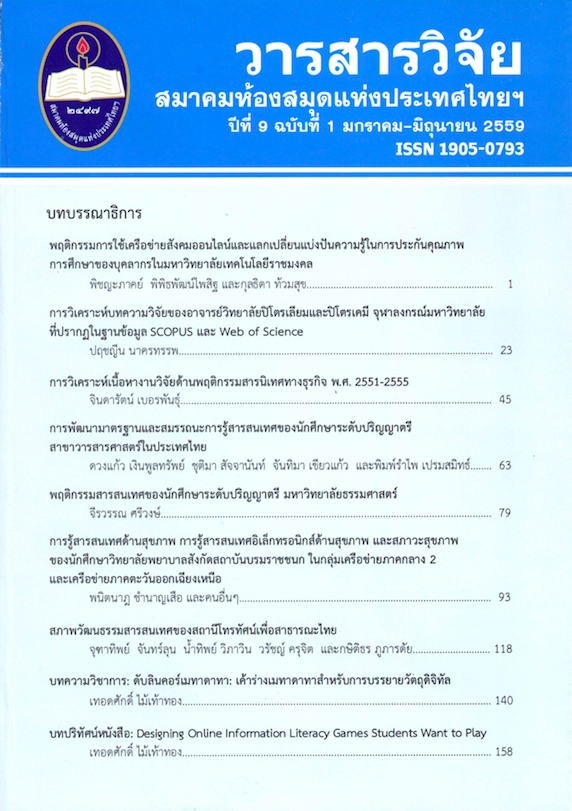การรู้สารสนเทศด้านสุขภาพ การรู้สารสนเทศอิเล็กทรอนิกส์ด้านสุขภาพ และสภาวะสุขภาพของนักศึกษาวิทยาลัยพยาบาลสังกัดสถาบันบรมราชชนก ในกลุ่มเครือข่ายภาคกลาง 2 และเครือข่ายภาคตะวันออกเฉียงเหนือ
Main Article Content
Abstract
งานวิจัยนี้เป็นการวิจัยเชิงสำรวจ มีวัตถุประสงค์เพื่อศึกษาการรุ้สารสนเทศด้านสุขภาพ การรู้สารสนเทศอิเล็กทรอนิกส์ด้านสุขภาพ สภาวะสุขภาพตามการประเมินตนเอง และ เพื่อเปรียบเทียบการรู้สารสนเทศด้านสุขภาพ การรู้สารสนเทศอิเล็กทรอนิกส์ด้านสุขภาพ และสภาวะสุขภาพของนักศึกษาวิทยาลัยพยาบาลสังกัดสถาบันพระบรมราชชนกในภาคกลาง2 และภาคตะวันออกเฉียงเหนือศึกษาในชั้นปีการศึกษาที่แตกต่างกัน โดยใช้แบบสอบถามแบบออนไลน์ ประเมินความสามารถทางสารสนเทศในมิติต่างๆ สุ่มตัวอย่างตามความสะดวก และขอความร่วมมือจากวิทยาลัยพยาบาลสังกัดสถาบันพระบรมราชชนกในเครือข่ายภาคกลาง 2 และภาคตะวันออกเฉียงเหนือ 7 แห่ง แบบสอบถามทางออนไลน์ จำนวน 1,948 คน วิเคราะห์ข้อมูลโดยใช้การแจกแจกความถี่ ร้อยละ ค่าเฉลี่ย ส่วนเบี่ยงเบนมาตรฐาน และใช้ Welch Tests และทำการทดสอบความแตกต่างรายคู่โดยวิธี Dunnett T3 ผลการวิจัย พบว่า
1) การรู้สารสนเทศด้านสุขภาพ ได้แก่ ทักษะในการประเมินสารสนเทศด้านสุขภาพและการรู้สารสนเทศทางวิทยาศาสตร์ระดับปานกลาง ความเชื่อถือได้ต่อสื่อสารสนเทศด้านสุขภาพหรือข้อมูลด้านการแพทย์ที่เผยแพร่ผ่านสื่อมวลชนระดับปานกลาง ความเชื่อมั่นต่อการได้รับสารสนเทศ และการนำไปใช้ ในประเด็นว่าจะได้รับคำแนะนำหรือสารสนเทศเกี่ยวกับสุขภาพเมื่อเกิดความต้องการอยู่ในระดับปานกลาง
2) การรู้สารสนเทศอิเล็กทรอนิกส์ด้านสุขภาพ ได้แก่ เนื้อหาสาระของข้อมูลด้านสุขภาพที่สืบค้นทางสื่อออนไลน์/สื่อสังคม มีค่าเฉลี่ยมากที่สุดในเรื่องการสืบค้นสารสนเทศเรื่องเกี่ยวกับเชื้อโรค ระดับการรู้สารสนเทศอิเล็กทรอนิกส์ด้านสุขภาพอยู่ในระดับมาก มีค่าเฉลี่ยสูงที่สุดในเรื่องการรู้วิธีการใช้อินเทอร์เน็ตเพื่อค้นหาคำตอบเกี่ยวกับปัญหาด้านสุขภาพ
3) สภาวะสุขภาพตามการประเมินตนเองของนักศึกษาพยาบาล โดยรวมอยู่ในระดับมาก มีค่าเฉลี่ยมากที่สุดในด้านสุขภาพร่างกายที่แข็งแรงสมบูรณ์ ช่วยเหลือตนเองได้ และไม่มีโรคเจ็บป่วยเรื้อรัง และ
4) เปรียบเทียบการรู้สารสนเทศด้านสุขภาพ การรู้สารสนเทศอิเล็กทรอนิกส์ด้านสุขภาพ และสภาวะสุขภาพของนักศึกษาวิทยาลัยพยาบาลที่ศึกษาอยู่ในชั้นปีการศึกษาแตกต่างกัน พบว่า การรู้สารสนเทศด้านสุขภาพ การรู้เท่าทันสื่อสารสนเทศอิเล็กทรอนิกส์ด้านสุขภาพ และสภาวะสุขภาพของนักศึกษาพยาบาลที่ศึกษาอยู่ในชั้นปีการศึกษาแตกต่างกัน มีความแตกต่างกันระหว่างชั้นปี อย่างมีนัยสำคัญทางสถิติที่ระดับ .05
Health information literacy, eHealth literacy, and Health status of nursing students in Nursing colleges under Jurisdiction of the Praboromarajchanok Institute (PBRI), in the Central Region 2 Network and North-eastern Region Network
The study aimed to compare self-reported health information literacy, eHealth literacy, and health status of the nursing students in different academic levels. Online questionnaire was used to collect data from 1948 nursing students enrolling in the Nursing Colleges underjurisduction of the Praboromarajchanok Institute (PBRI in the Central Region 2 Network and the North-eastern Networks. Frequency distribution, percentage, mean and standard deviation, were used to describe the data, and Welch tests and Dunnett T3 were used to compare the differences of health information literacy, eHealth literacy and Health status among the nursing students studying in different academic level. It was found that
1) The samples had average mean scores of health information literacy, information evaluation, scientific literacy, and trust of health information in the mass media, reliability of the health information and its implication were at the moderate level, respectively.
2) The samples had average mean score of the eHealth literacy at the high level with the highest mean score on the item “knowing how to use internet to find out the solutions of health problems” was the highest rating As for the online health information content searched for, it was found that searching on germs had the highest mean score at the highest level
3) The samples had average mean score on health status at a high level; with the highest mean score on physical condition, being independent, and having no chronic disease.
4) It was found that the samples who were studying in different year level had statistical different mean scores on health information literacy, eHealth literacy, and health status at significance level p<.05.
Article Details
บทความทุกเรื่องที่ลงตีพิมพ์จะได้รับการตรวจอ่านโดยผู้ทรงคุณวุฒิ ความคิดเห็นและบทความที่ปรากฏในวารสารนี้ เป็นของผู้เขียนซึ่งมิใช่เป็นความคิดเห็นของคณะผู้จัดทำ และมิใช่ความรับผิดชอบของสมาคมห้องสมุดแห่งประเทศไทยฯ การนำบทความในวารสารนี้ไปตีพิมพ์ซ้ำต้องได้รับอนุญาตจากคณะผู้จัดทำ
All articles submitted for publication will be reviewed by the academic reviewers. The editorial board and TLA claim no responsibility for the content or opinions expressed by the authors of individual articles or columns in this journal. Reprinting of any articles in this journal must be permitted by the editorial board.

